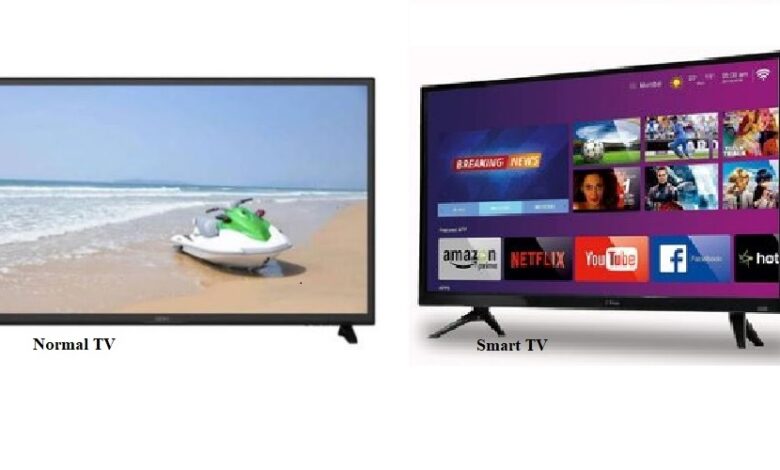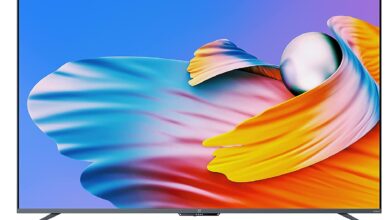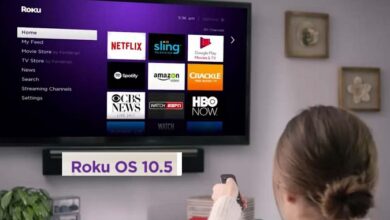Difference between Smart Tv and Normal Tv
Understanding the Features that Set Smart TVs Apart from Traditional TVs

Smart TV, unlike a normal TV, can connect to the internet via Wi-Fi. A Smart TV may also be able to run apps that are pre-installed on the device.
A television (TV) is a gadget that allows you to watch a moving image while listening to music. While all televisions serve the same objective, the way they operate is different. It’s also possible that their constituents differ. LCD and LED televisions.
The fundamental distinction between a Smart TV and a regular television is that a Smart TV is more intelligent than a regular television. It is referred to as “smart” since it is capable of more. It may first and foremost connect to the internet via Wi-Fi.
In today’s technology and internet-driven world, this is a must-have feature.

Smart television can also come with apps that allow them to get information from the internet. These apps also enable the TV to stream content without the need for any additional hardware, as long as it has internet access. It should also have a built-in web browser so that you may access content on the internet.
Smart television may also provide Internet TV, On-demand streaming media, such as Netflix, Amaxon Prime, Prime video, YouTube, and other Television shows and movies which can be broadcasted over the web, as well as over-the-top content (OTT), i.e. audio, video, and other media over the Internet. A Smart TV may even have home networking capabilities, allowing it to serve as the home’s media centre.
A Smart TV may also have online interactive media, allowing viewers to engage with the television via a remote or other device, or by simply touching directly if the device includes a touch screen.
- Kubernetes and Its 4 Services: A Comprehensive Review
- BEST LED TV UNDER BUDGET RS 25000- A Report
- How to Watch Fetch TV in Canada? [2022]
- Roku Streaming Stick 4K vs. Amazon Fire TV Stick 4K: Who’s the Winner?
What is the difference between a Smart TV and a Regular TV?
A Smart TV can connect to the internet via Wi-Fi, whereas a regular TV cannot. A Smart TV may also be able to run apps that are pre-installed on the device.
A television (TV) is a gadget that allows you to watch a moving image while listening to music. While all televisions serve the same objective, the way they operate is different. It’s also possible that their constituents differ.
A Smart television can be thought of as a cross between a television and a computer, as it performs the basic functions of a television while also incorporating technology and services traditionally associated with computers.
However, that while all of these features are found in most Smart TVs, each Smart television is unique. The actual characteristics of Smart television may differ in reality depending on the version of the TV, the manufacturer, and the numerous technologies. Some might not have all of these features, while others might have more. As a result, it is best to check the characteristics of each Smart television separately.
A regular television, on the other hand, does not have all of these functions. It’s just a regular television, like most people are used to. However, numerous more gadgets, such as Chromecast, Roku, and others, are available that deliver part of similar capability to a regular TV. These products are designed to transform a regular television into a smart television.
Comparison between Smart TV and Normal TV:
| Type | Smart TV | Normal TV |
| Description | A tv that has access to the internet, hence is ‘smarter’ than a normal TV. | A normal television that only allows one to view picture and listen to voice, like vedio |
| Functionality | Both function TV and computer | Like normal TV |
| Internet | It onnect the internet | It Cannot connect the internet |
| Web Browser | The web browser some time | It Usually does not have an inbuilt web browser |
| Wi-Fi | It Needs Wi-Fi for its features | It Does not need Wi-Fi |
| Built in Apps | It Had built in apps | It Does not have built in apps |
| Streaming | It Can stream content | It Needs additional equipment to stream content |
| Touchscreen | It May have a touchscreen | does not have a touch screen |
Smart televisions
A Smart television, often known as an Internet TV, is any television that can access additional programming via the internet. It’s the equivalent of having a computer embedded into your television. Smart television differ from regular televisions in several ways, the most notable of which is their ability to connect to the internet and the presence of several built-in apps such as Netflix, YouTube, and Facebook. However, most Smart television operating systems aren’t upgradeable, which means that if new apps or services, such as Hulu or Kayo, become available, you may need to buy a whole new TV to accommodate them.
Smart TV’s Advantages and Disadvantages
Pros-
- Interface that is simple and easy to use.
- An all-in-one TV that requires no setup
cons-
- A small number of apps are available.
- Firmware upgrades are less regular, and systems may become obsolete.
How Do Smart Televisions Work?
Smart TVs connect to the internet over the same broadband router and Ethernet or Wi-Fi network that you use to connect your computer. Although Ethernet provides the most robust connection, Wi-Fi may be more handy if your TV is in a separate room or a great distance from your router.
User will be prompted to input any login credentials needed by ISP once your TV is connected and switched on (Internet Service Provider). An on-screen menu will appear on the smart television, with a number of options online networks in the format of apps (similar to the apps on a smartphone). Some applications are pre-installed, and can add more by downloading them.
When you click on a channel/icon, app’s you’ll be transported to that channel/content app’s offers, which you can select and view.
The way you navigate the smart TV menu and control your apps differs depending on the brand and model.
Platform for Apps by Smart television Brand
Apps are offered by one or more TV companies through one or more platforms. (A TV’s smartness is due to this integrated platform.) Here are a handful of the brands/platforms you might come across: User will be taken to that channel/content app’s offers when click on a channel/icon, which you can select and view.
Depending on the brand and model, the way you navigate the smart television menu and control your apps varies.
Apps by Smart TV Brand Forums
- Amazon Fire TV from Element, Toshiba, and Westinghouse
- Hisense/Sharp, Hitachi, TCL, Philips, Insignia, Hisense/Sharp, Philips, Philips, Philips, Philips, Philips, Philips, Philips, Roku TV is an element.
- WebOS is LG’s operating system.
- Samsung’s Smart Hub for Tizen
- Android TVs from Element, LeECO, Sharp, Sony, Toshiba, and Westinghouse
- JVC, LeECO, Philips, Polaroid, Sharp, Skyworth, Soniq, Sony, Haier, JVC, LeECO, Philips, Polaroid, Sharp, Skyworth, Soniq, Sony Chromecast (Toshiba)
- NetTV (Philips)
- VEWD (sharp)
- SmartCast or Internet Apps Plus from Vizio
- One or more TV providers offer apps through one or more platforms. (This integrated platform is responsible for a TV’s intelligence.) Here are a few examples of brands/platforms you might encounter:
The Advantages of Smart TVs
The main advantage of a smart TV is that it provides access to a huge number of channels that provide TV shows, movies, and music even without a TV antenna or a cable/satellite subscription. Web browsing, gaming, and access to quality media files stored on computers are all available on some smart TVs.
Although smart TVs can get Television programs via antenna, cable, or satellite, Vizio has gone so far as to remove built-in tuners and antenna/cable connectors from the majority of its sets in favour of its built-in streaming platform as an all-encompassing substitute.
Extra Smart TV Features
Some smart TVs have additional features, like Miracast and File Sharing, which allow users to see material from compatible smartphones and tablets on a TV screen. SmartShare (LG) and SmartView are two other names for this capability (Samsung).
Most smart TVs can even stream material from the TV to a smartphones via a suitable app. After transmission, the user can view the information on their smartphone, away from the television.
Additional Amount and Restrictions
The allure of smart TVs is great, but there are some price points and constraints to consider.
Whereas many smart TV platforms offer free channels and services, some need a monthly subscription or a pay-per-view price. When you total up all of those expenses, you can find yourself spending as much as, if not more than, a monthly cable/satellite subscription. Users will, on the other hand, only be charged for the channels and content that you desire.
The programs and features available to are determined by the smart TV’s manufacturer and model. Despite the fact that all smart TVs have access to many of the same key services (Netflix, Vudu, Hulu, Pandora), some smart TV systems may not have access to a large number of supplementary and specialty channels. Also, as of 2018, no TV has the capacity to access streaming audio and video material through iTunes, so even if you have a smart TV, you’ll need to get an Apple TV box.
What is the distinction between a television and a smart television?
Smart TV and Android TV have inclusive relationships, and Android TV has practically all of the features of smart TV but with the Android operating system. When launching smart TV, several TV makers additionally include their own built-in operating system.
Can a normal TV become a smart TV?
Your conventional TV can be transformed into a smart one with the help of android boxes and firesticks. With an excellent smart TV alternative – Android Box – you can watch your OTT shows, cast material from your phone, play games on TV, view in higher video quality, and do so much more. They work well as a smart TV converter.






